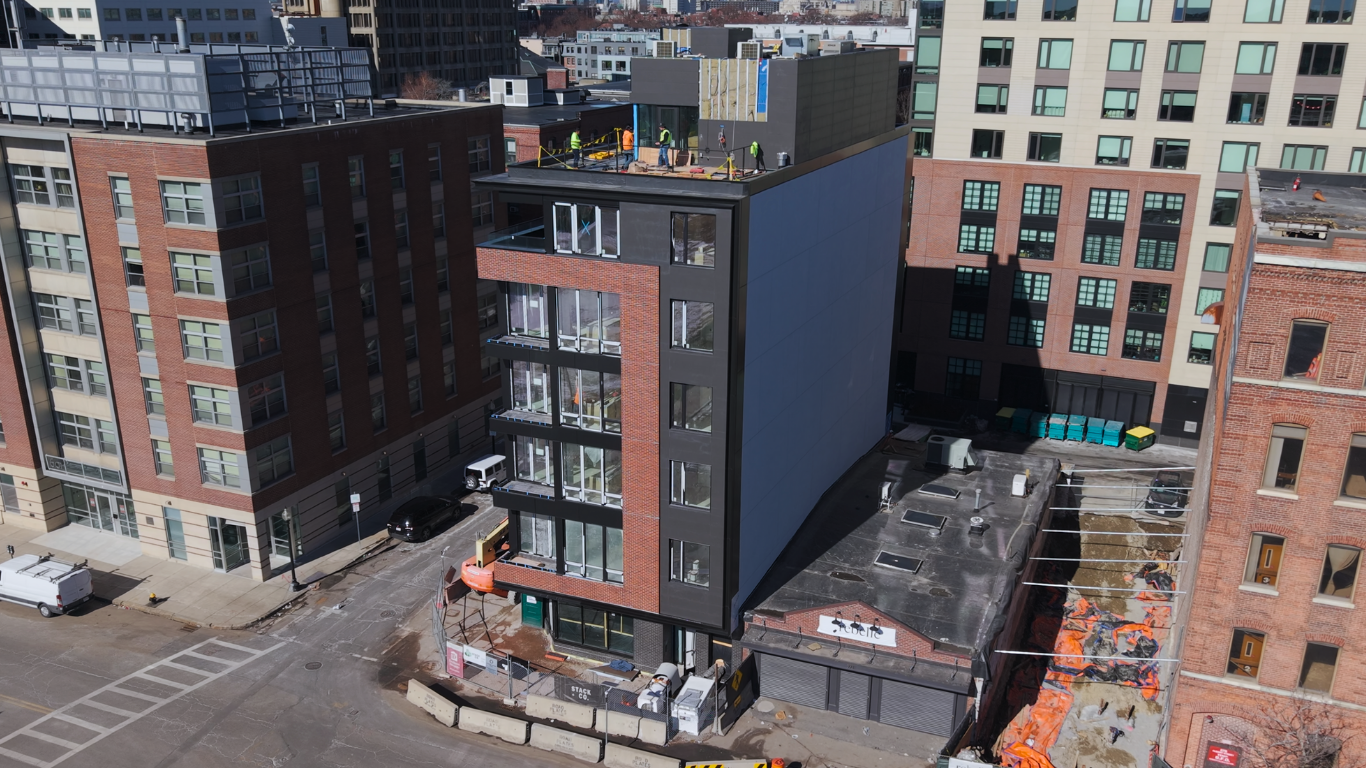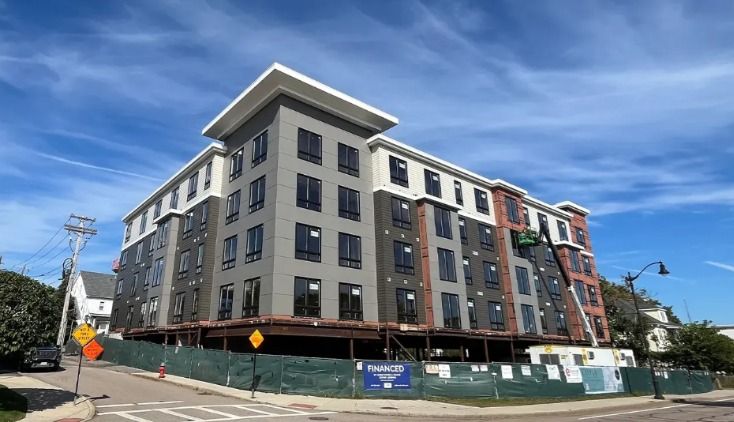Our Blog
NEWS & ARTICLES
Insights, Tips, & Inspiration

In large construction projects, every decision creates a ripple effect, from design and budgeting to long-term performance and client satisfaction. Among those choices, siding sits right at the intersection of aesthetics, durability, and value . For general contractors and developers in Massachusetts, selecting the right siding system isn’t just a design decision, it’s a strategic investment that shapes financial return, market appeal, and the long-term resilience of the entire build. Why siding really matters It’s easy to think of siding as just the “skin” of a building, the final layer that defines its look and protects what’s inside. But in reality, siding plays a key role in energy performance, weather resistance, and lifetime maintenance costs . In commercial, multifamily, and mixed-use developments, the siding system directly impacts: Property value and resale potential Operational and maintenance budgets Tenant satisfaction and occupancy rates Energy efficiency and insulation performance Compliance with local codes and sustainability standards In other words, smart siding decisions can make or break the total cost of ownership. The ROI of quality siding Massachusetts weather doesn’t go easy on buildings. Between Nor’easters, humidity swings, and constant freeze-thaw cycles, siding systems are always under stress. Choosing premium materials and partnering with an experienced installation team pays off in durability, efficiency, and peace of mind. A high-performing siding system can: Prevent costly repairs caused by moisture or warping Lower insurance risks related to fire, impact, and severe weather Improve thermal performance and energy efficiency Enhance curb appeal, a major factor in leasing and resale value According to multiple building performance studies, fiber cement and engineered wood siding deliver some of the highest ROI among all exterior construction materials, even on large-scale commercial projects. Why material choice makes all the difference Not all siding materials perform the same, and on big projects, even small differences multiply across thousands of square feet. Here’s what general contractors and developers should consider: Fiber Cement Siding: Exceptionally durable, non-combustible, and ideal for New England’s climate. Often the top choice for multifamily and commercial buildings that require fire resistance and longevity. Engineered Wood: Offers a natural wood look with lighter weight and advanced coatings that resist rot, insects, and UV fading. Vinyl and Composite Systems: Cost-effective for mid-market projects, providing flexibility, color variety, and minimal maintenance. Metal Panels: Popular for modern commercial façades — sleek, weather-resistant, and architecturally versatile. Each option strikes a different balance of cost, appearance, and performance, but true success lies in how it’s installed, through precise detailing, proper moisture control, and alignment with the architect’s intent. Long-term value: Thinking beyond installation The real cost of siding isn’t just in the materials or labor, it’s in how it performs over decades. A properly installed system that prevents water infiltration, resists fading, and minimizes maintenance needs can dramatically reduce ownership costs. It also helps property managers and investors maintain a stronger ROI through fewer repairs and happier tenants. At Lifetime Contractors, we approach every siding project with long-term value in mind, focusing on craftsmanship, warranty integrity, and durability. Because when your trade partner understands the financial impact of performance, everyone wins: the General Contractor, the client, and the end user. How siding impacts market value When it’s time to sell, lease, or showcase a property, perceived quality is everything. Siding often defines a building’s first impression, its texture, color, and overall aesthetic coherence. Modern siding systems open the door to creative design, from vertical panels and board-and-batten accents to mixed-material façades, transforming even simple layouts into standout structures with real market presence. In competitive markets like Massachusetts, this kind of design distinction adds tangible marketability , often translating to higher sale prices and shorter vacancy cycles. Collaboration: Where siding meets project efficiency In large developments, great craftsmanship isn’t enough, coordination is everything. Siding installation must integrate seamlessly with framing, insulation, and window systems to avoid rework and keep schedules on track. That’s where the right partner makes all the difference. A specialized siding contractor brings not only technical skill but also logistical insight, sequencing work efficiently, managing scaffolding and lifts, and reducing trade overlaps. At Lifetime Contractors, we work hand-in-hand with general contractors to ensure the siding phase enhances overall project flow, staying on schedule, maintaining quality, and delivering consistent results across every square foot. Sustainability and code compliance Massachusetts enforces some of the strictest energy and fire safety codes in the Northeast. Modern siding systems are critical in meeting, and often exceeding, those requirements. From fiber cement’s Class A fire rating to advanced air and moisture barriers that cut energy consumption, siding plays a major role in a project’s sustainability goals. For LEED or green-certified developments, using eco-friendly or recyclable materials helps meet certification standards while future-proofing your design. The Massachusetts advantage Partnering with a local siding expert who understands regional climate patterns, materials, and inspection processes can make all the difference. With years of experience across Massachusetts, Lifetime Contractors knows what works in each region. We’ve seen how the right siding system doesn’t just protect a building, it elevates it, transforming a structure from functional to exceptional. Let’s build the next facade together For general contractors and developers planning projects for 2026 and beyond, now’s the time to start thinking strategically about your siding systems. The decisions made in pre-construction will determine your project’s durability, efficiency, and long-term success. Lifetime Contractors partners with leading General Contractors across Massachusetts to deliver siding systems, combining precision, reliability, and a shared commitment to excellence. Contact us today for a free estimate or to discuss how we can support your next large-scale development.

If you’re a general contractor, developer, or construction manager in Massachusetts, you already know that the success of your 2026 projects starts with the partnerships you secure today. At Lifetime Contractors, our 2026 calendar is officially open. We’re now accepting requests for free estimates and pre-construction consultations for large-scale developments across the state. Whether you’re finalizing budgets, assembling bid packages, or refining your drawings, early planning is what keeps your framing and siding scopes running smoothly, and your entire project on track. Why early planning changes everything In Massachusetts, construction timelines live and die by the weather. Framing and siding are both highly seasonal trades, with limited windows for top performance and productivity. Contractors who plan ahead, lining up qualified crews, locking in material pricing, and scheduling inspections, are the ones who deliver on time while everyone else scrambles to catch up. Waiting until spring or early summer to secure your framing or siding teams can lead to: Limited availability from trusted subcontractors Higher material costs driven by seasonal demand Tight schedules that cause rushed work and coordination issues On the other hand, getting on the schedule early means: Priority access to skilled framing and siding crews Better pricing stability on materials A smoother workflow between trades, with fewer overlaps or delays Many of our clients tell us that early coordination with Lifetime Contractors saved them weeks on their timeline, and thousands in rework and delay costs. Now booking: 2026 construction projects We’re currently scheduling large-scale wood framing and siding projects for 2026, including: Multifamily and mixed-use developments Commercial and institutional buildings High-end residential complexes Our estimating and project management teams are already reviewing proposals for projects breaking ground next spring and summer. If you’re planning new developments for 2026, this is the moment to get organized — finalize your paperwork, secure permits, and select a framing and siding partner who can keep everything on schedule. Why general contractors choose Lifetime Contractors Over the years, we’ve built strong, long-term partnerships with general contractors and developers across Massachusetts who value our ability to: Stay on schedule: Our teams are structured for speed, precision, and reliability, even on complex, multi-phase projects. Maintain consistent quality: Every crew member follows strict company standards and safety procedures. Communicate clearly: You’ll always know where your project stands and what’s next. Handle complex scopes: From detailed architectural framing to large-surface siding, we’re experienced in multifamily and commercial-grade builds. Respect the chain of command: We integrate seamlessly into your project management workflow, respecting how your teams operate. We’re a reliable trade partner committed to helping you meet deadlines, pass inspections, and exceed client expectations. The advantage of working with Lifetime Contractors 1. Proven Expertise in Wood Framing From load-bearing walls and fire-rated assemblies to engineered lumber and complex rooflines, our framing crews know how to build it right. We follow Massachusetts building codes, maintain strict quality control, and adapt to each project’s structural and architectural needs. 2. Advanced Siding Systems We install all major siding materials — fiber cement, engineered wood, vinyl, and composite systems — always to manufacturer specs for warranty and performance. Our team is highly experienced in rainscreen systems and weatherproofing details, essential for New England’s climate. Proper flashing, fastening, and WRB integration are non-negotiable in our process. 3. Communication first Clear scheduling and proactive coordination are at the core of how we work. From the moment we’re contracted, we partner with your superintendents and site leads to align framing and siding with your master schedule. 4. Safety as a Core Value All Lifetime crews are OSHA-trained, fully equipped, and operate under a strict zero-tolerance safety policy. Every site plan is designed with fall protection and hazard prevention in mind, protecting both our team and your liability. Massachusetts projects, built with local insight Working throughout Massachusetts, we understand the regional challenges that impact construction, from coastal corrosion and snow loads to municipal inspections. This local experience helps us anticipate issues before they ever reach your desk. We know which fasteners last on the coast, which insulation performs best in humid conditions, and which cities require special framing certifications. When you work with Lifetime Contractors , you’re choosing a partner who knows how to get projects built, and delivered, in New England’s unique environment. Secure your spot for 2026, contact Lifetime Contractors today If you want your 2026 builds framed and sided by a partner known for quality, reliability, and performance, now’s the time to act. We’re booking fast for the 2026 season. Call our estimating team or visit our website to request your free project estimate today. Let’s plan it right and build it strong, together.

When a developer or general contractor is seeking a framing partner for large-scale projects, whether multifamily developments, condominiums, or commercial buildings, it takes more than execution capacity. What’s needed is proven experience, strict standards of quality and safety, and a team that understands tight schedules. Lifetime Contractors Inc. delivers exactly that. Since 2015, serving Boston and surrounding areas, the company has completed almost 500 projects, with over 2.3 million square feet of framing to date. Our proven track record Scale and experience you can trust Established in 2015 , with a solid reputation across Massachusetts. Almost 500 completed projects , ranging from residential to large commercial developments. Over 2.3 million square feet of framing delivered, demonstrating capacity for high-volume work. Skilled team and safety commitment Dedicated Framing Field Managers ensure oversight and quality on every site. Crews are OSHA 10 and OSHA 30 certified, fully insured, and trained in rigorous safety protocols. Compliance with local building codes and a culture of “everyone goes home safe every day.” Integrated services for builders Lifetime Contractors offers more than framing: siding, roofing, and decking are also part of the package. This integrated approach eliminates trade conflicts, reduces delays, and ensures consistency across the building envelope. Why general contractors choose Lifetime Contractors 1. Scalable workforce for large projects With multiple field managers and experienced crews, Lifetime can handle simultaneous jobsite operations, crucial for multifamily and commercial projects on accelerated timelines. 2. Commitment to deadlines, safety, and communication From the start, clients receive clear and consistent updates. Meeting deadlines while upholding safety and quality is a non-negotiable priority. 3. Workmanship guarantee Lifetime provides a one-year workmanship warranty, giving contractors peace of mind and reducing post-delivery risks. 4. Compliance and professional standards The company maintains all necessary licenses, liability insurance, and workers’ compensation coverage, operating with full transparency and compliance. Choosing the right framing partner: How Lifetime Contractors stands out
